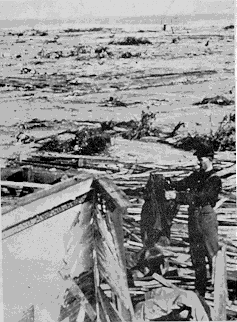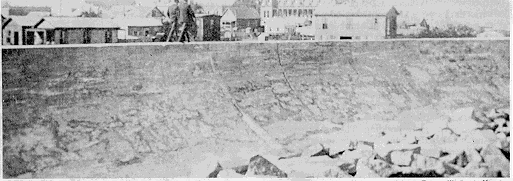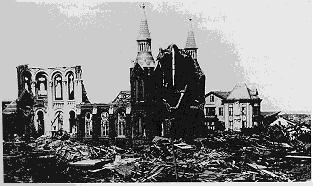

Galveston Island is a long, narrow barrier beach that runs
parallel to the Texas coast some two miles away across Galveston Bay. The
City of Galveston occupies the eastern end of the island. In 1900, the only
connections to the mainland were "the longest wagon bridge in the United
States" and 3 wooden railroad trestles.The census of 1900 put Galveston's
population at 37,789. There were 40 miles of street car line, 2,028 telephones,
and 2 automobiles.
On Sept. 8, 1900, virtually
the entire island of Galveston was underwater. The killer storm had
moved west from Cuba, past the tip of Florida and strengthened as it churned
through the Gulf of Mexico as shown in map above.
The hurricane hit Galveston in the late afternoon on Saturday, September 8th,
and did not vanish until midnight! Winds reached up to 130 miles per
hour, and a storm wave said to be "nearly five feet high" demolished nearly
the entire city.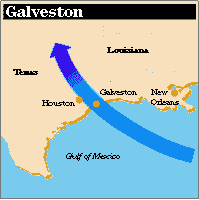 LETHAL WEAPON:
WAVES AND WINDS CRUSHED MOST OF THE CITY.
LETHAL WEAPON:
WAVES AND WINDS CRUSHED MOST OF THE CITY.
DATE:
SEPTEMBER 8TH-9TH, 1900
DEATH TOLL:
ABOUT ONE OF EVERY SIX GALVESTON RESIDENTS KILLED.
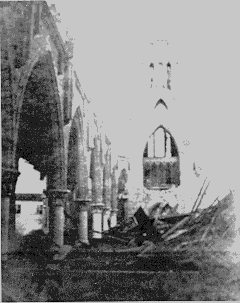
The reason for the approximate 6000 deaths in Galveston, and the approximate 2000 deaths elsewhere is that there was no evacuation, because this category-4 storm caught people by surprise. There was not an outside warning, and the populace did not recognize early, local indicators. Ironically, as the storm approached, many people gathered at the beach to watch the high waves.
It left 1,000 survivors naked and 5,000 more bruised and battered. In a 1,500-acre area of total destruction, 2,636 houses-nearly half the homes in the city-were swept out of existence. Elsewhere, at least 1,000 more were reduced to wreckage. Not a single building escaped damage. To sum it up On Sunday, September 9th, Galveston was "a city of wrecked homes and streets choked with debris and six thousand corpses. It was a city whose very cemeteries had been emptied of their dead as if to receive new tenants."
Physical geographers had said that because of the long
, gentle slope of the sea bottom, Galveston was safe from the full fury of
tropical storms. Experience seemed to support their claim.
Galveston had been hit fairly hard by major storms in the past-particularly
in 1875 and 1886- the loss of life was fairly small. However, the storm
that proved them all wrong, was brewing 4,000 miles away, over the tropical
Atlantic West of the Cape Verde Islands on about the 27th of August. The
disturbance moved to the west-northwest, gaining size and strength. On
the 31st, the storm center passed just south of Puerto Rico, and early Sunday
morning, September 2, had crossed the Dominican Republic and Haiti. On
the 3rd and 4th the storm began heading towards the Gulf of Mexico. On
Wednesday, September 5, as it raked the Florida Keys, the tropical storm
became a full-blown hurricane. On Friday September 7, several
inches of sea water covered streets up to four blocks in from the beach on
the Gulf side of the city. By 5 o'clock the tide was already 4 1/2 feet above
normal, despite a 15 to 17 mile per hour north wind. Blowing offshore against
the incoming water, a north wind should have caused a low tide at Galveston.
At 10:10 a.m., the Weather Bureau in Washington telegraphed that the
storm center was now expected to pass west of the city, which would put Galveston
in the dangerous right semicircle of the storm. By noon, the wind was blowing
out of the northeast at more than 30 miles per hour and increasing steadily.
Galvestonians coming home for lunch had to wade through water up to their
waists and sometimes their chins to reach their houses.The wagon bridge and
train trestles connecting Galveston to the mainland were now submerged under
the rising waters of the bay, which were flooding inland over the wharves
along the northern side of the city.
It was now too late to get off the island!!!!!!!!!
The rambling wooden buildings of St. Mary's Orphanage stood on the beach 3 miles west of the city. They housed 10 Roman Catholic Sisters of the Incarnate Word, 93 orphans, and a workman. By 10 o'clock Saturday morning, the water was already 3 feet deep. Later, as the storm worsened, the sisters took the children to the chapel on the first floor of the girl's building. They stayed there praying until rapidly rising water drove them to the second floor. From there they watched the boy's building break up in the storm.About an hour later, the roof of their own building collapsed. With death threatening, the sisters tied the children together in groups, then to themselves, attaching ropes to their waists. Only a few scattered bricks from the foundations marked the site of the orphanage after the storm. Ninety bodies were found nearby, including those of two of the sisters. The bodies of two other nuns, Sisters Raphael and Genevieve, were found at Texas City, on the mainland. Six more were found elsewhere on the island and mainland. One nun still had nine small children tied to her body; another was holding a child in each arm.
All that remained of thousands of homes and of many of the people who had lived or sought shelter in them was a 3-mile long mound of wreckage jammed with bodies forming a semicircle around the business district. An estimated 8,000 to 10,000 survivors were homeless. The bay was clogged with hundreds of human bodies, and the corpses of cows, horses, chickens, and dogs were everywhere. In most cases, identification was impossible. As more and more bodies were uncovered, the survivors began to realize the true scope of the disaster.The corpses were weighted and thrown into the Gulf. Many, however, floated back onto the beach with the incoming tide. On-the-spot burial or burning were the most practical solutions. On Tuesday Galveston became a city of funeral pyres. A dark pall of smoke hung over the island for weeks as the grim work continued. On October 3, almost a month after the hurricane, the body of Cora May Cline, identified by her engagement ring, was discovered under the wreckage which had carried her husband and children to safety. She was buried in Galveston Cemetery.
On the night of August 16, 1915 the city was tested by another great hurricane that followed closely the track of the 1900 storm. It brought winds of 92 miles per hour with gusts to 120 miles per hour, 10- to 14-foot storm tides, and 21-foot waves. This time, however, thanks to the seawall built by the people of Galveston after the disaster of 1900, and the raising of the grade, fewer than a dozen people were killed in the city.
